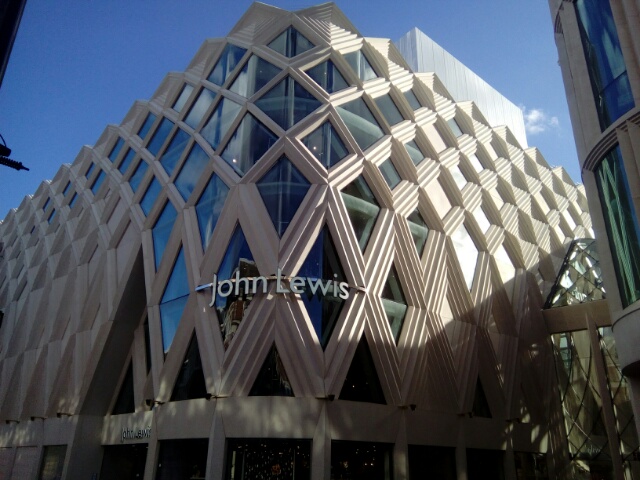
According to Hammerson’s, the developer of Victoria Gate, these vibrant arcades full of aspirational goods are meant to attract the “highly affluent of Harrogate, Ilkley and York”, as well as the local “fashion conscious shopper” and “the strong population of wealthy students.”
That counts me out. As one of the lowly skint from LS12, and a self-confessed fashion inadequate, I wouldn’t recognise a designer brand if one fell off the back of a lorry. Plus I’ve never even met a wealthy student. I suspect the only time I’ll ever step inside the John Lewis is in the event of a sudden downpour and I can’t make it to the market.
Still, I pass by the place two or three times a week, usually aboard the Number 48 bus on my way back from the not so well-to-do outskirts of Wakefield. I’ve watched the place grow – or perhaps “watched it assembled” is the more accurate phrase. And I’ve had plenty of opportunity to contemplate the process. The traffic congestion on Eastgate owing to construction work has been horrendous and many times I’ve been stalled between bus stops observing steel erectors, panel fixers and glass putter-inners working their magic. Finally this week the builders will clock off for the last time, the heras fencing will be removed, the shelves will be stacked with luxury goodies and the ribbon across the entrance will be snipped. I thought I’d have a final wander around the place before the carnival of consumerism commenced.
I’ve always approached the development from the back end and the first thing you see is the new car park.
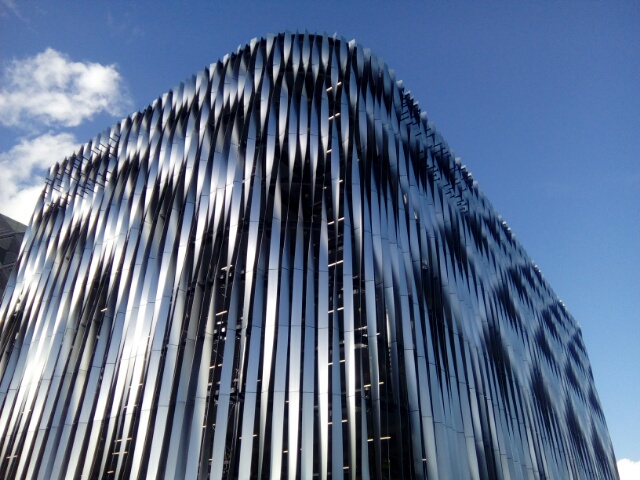
The inspiration for this structure was Leeds’ textile heritage, the “twisted fins creating an illusion of woven fabric.” The twisted fins also “take inspiration from the dynamic geometry of wind turbines.” Probably I’m being dense, but I find it impossible to imagine any relationship between a length of Worsted yarn and a structure which is basically a large propeller.
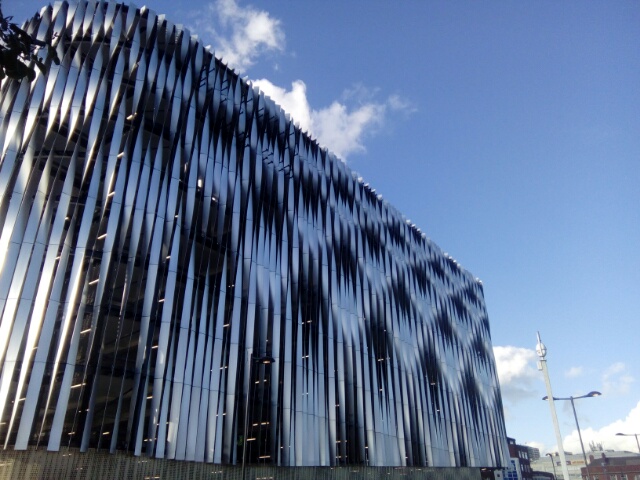
Also, to my untutored eye, the shimmering silver strips appear unwoven, or “naturally ventilated” as the website puts it (does this mean it’s a bit drafty?) … but that’s just me being literal, and why I’ll never be an architect.
My car-querying friends won’t appreciate me for saying this but I really like the building. Forget the guff about fin-like textiles and knitted turbines, the structure is a pleasure to look at and a great improvement on what was there before. Compared to the drab and dingy car park over at the back of the market, which has all the aesthetic appeal of a shoe box left out in the rain, this is in a different league.
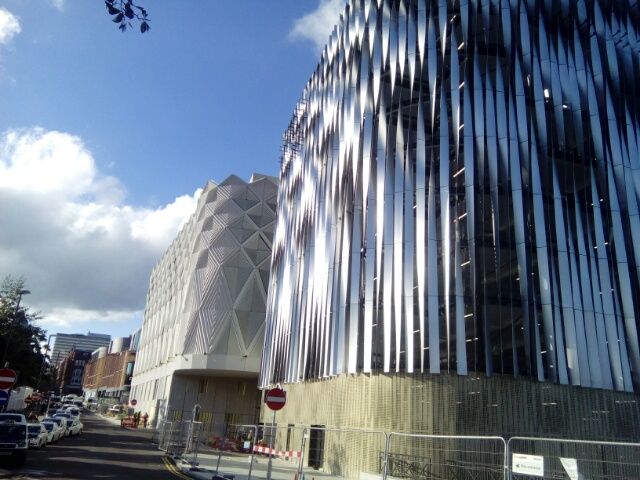
Go around the corner to the bottom of Eastgate and it’s a different story. The artist impression of this space on the photo gallery on the Victoria Gate website shows a light, open, airy space with no heavy traffic and dozens of sprightly pedestrians enjoying the scenery. The reality is otherwise. There ought to be a “No Flaneurs” sign with a big red cross over an image of a chap walking a turtle here. This is a major bus route with constant traffic grinding along both ways and very few opportunities for pedestrians to get from one side to the other quickly and safely (and let’s cover our eyes to the unspeakable crossing to the Playhouse and pretend it never happened.)
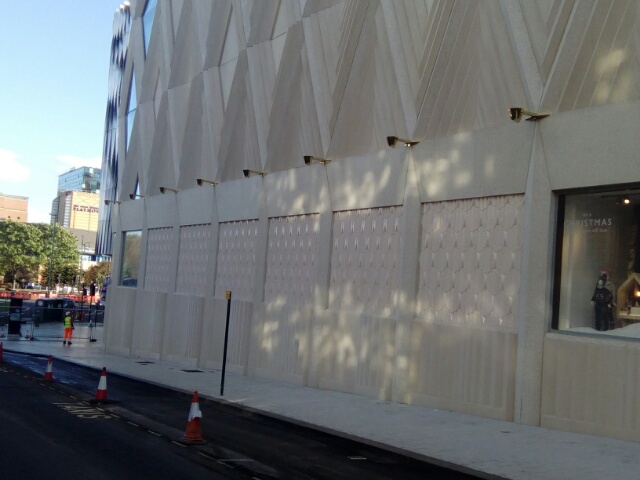
The John Lewis building does nothing to improve lower Eastgate, seemingly turning it’s back on the street with a “pfft”. Whenever I pass I get an urge to punch a hole through the blanks in the bare wall. Shoppers who venture down this part of town, which mainly consists of betting shops, pawn shops and wig shops aren’t the target demographic, that’s plain to see. (Austerity seems to have stimulated demand for false hair pieces – I wonder if John Lewis will stock a bespoke barnet brand?)
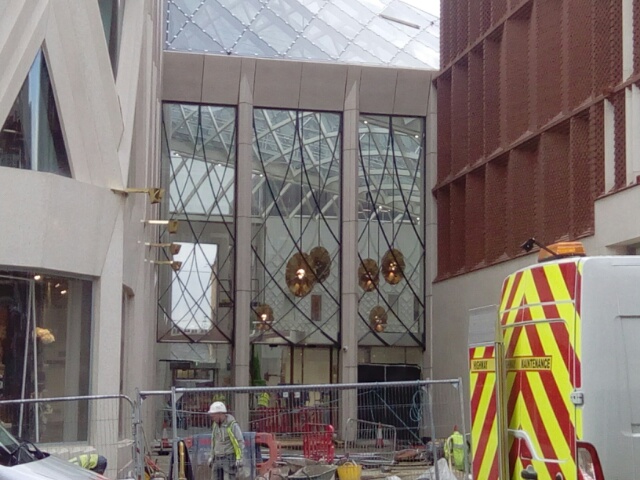
Further up things improve tremendously. There’s some windows, an atrium (I think it’s an atrium – is it an atrium? I’m not actually sure what the definition of an atrium is, though I am aware that you can’t build “iconic” in Leeds without promising an atrium and a boozer in the clouds) and a door. That’s inviting.
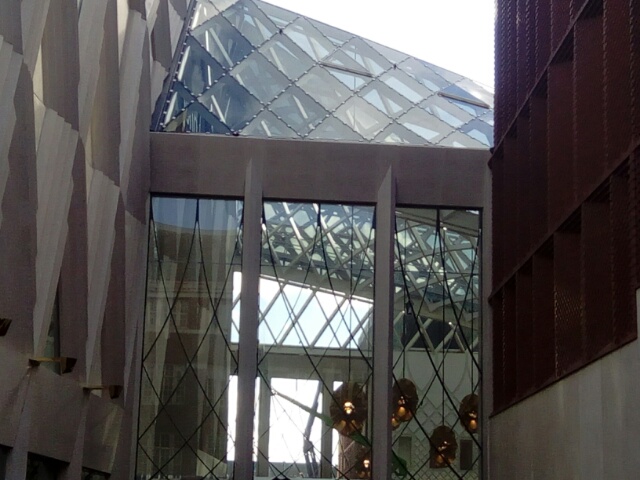
But still the entrance is set so far back from the street it’s almost as if it doesn’t want to be associated with the area.
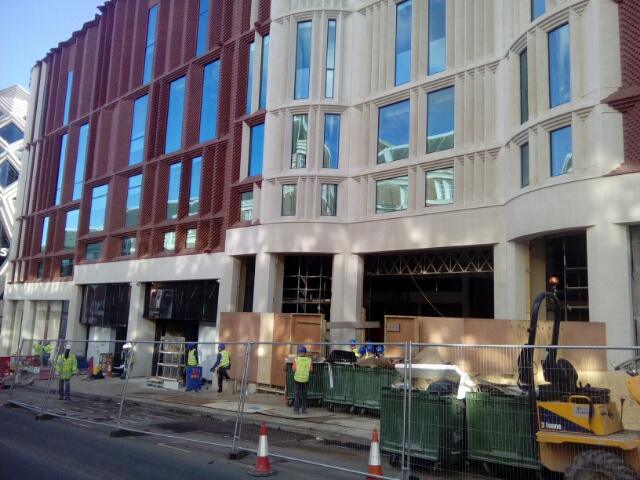
The next building along,Victoria Gate arcade, works well with the street opposite; similar height, similar colours, similar feel, solid and understated. It settles into the space nicely.
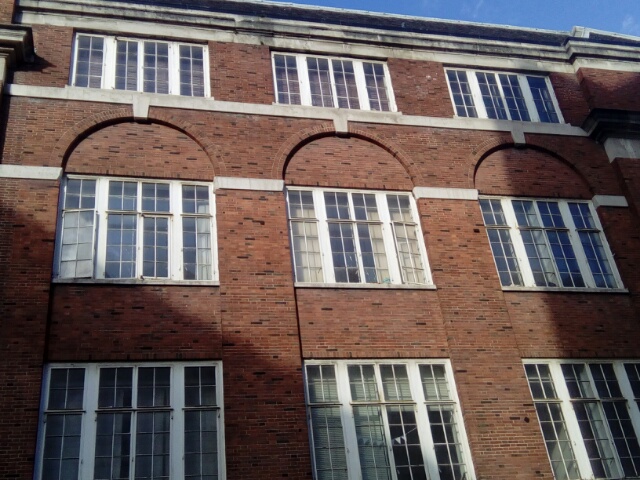
Left onto Vicar Lane and the new development has to face up, square off and put on a show against the matchless County Arcade
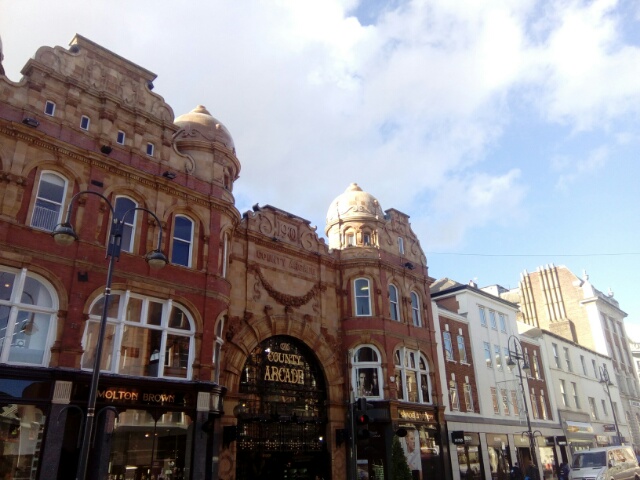
And the less showy but fine buildings on Sidney Street
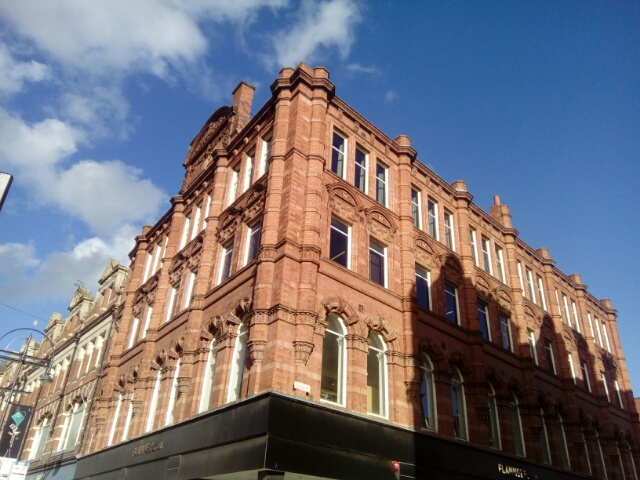
So at first sight this is a little disappointing.
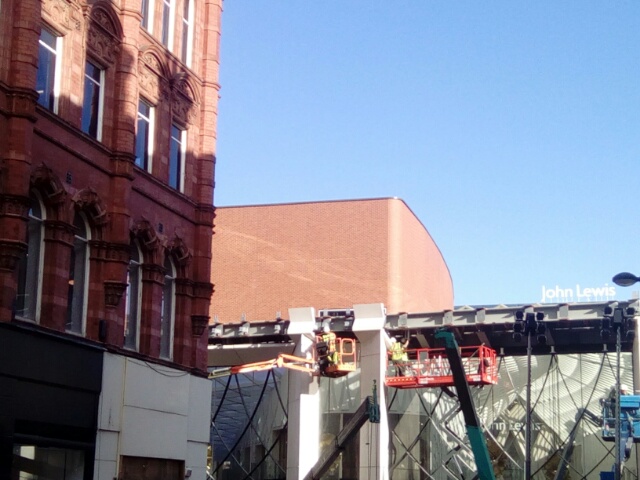
Square brick box? I know there’s a clever glass frontage below but can’t help noticing that banal brick bulge on the top.
But turn left again onto George Street, walking beside the market, and wallop!
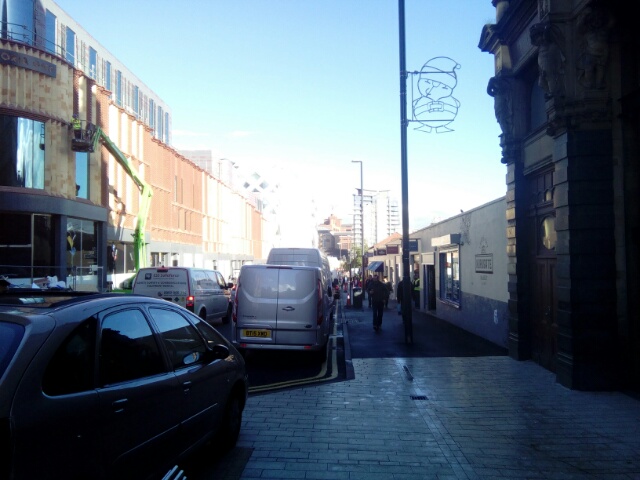
Eighteen months or so ago this was a wretched pot-holed eyesore with a police station at the bottom designed by a visually impaired sadist on an etch-a-sketch. Remember Millgarth? No, really don’t. It’ll give you nightmares.
Now I know I’m meant to be a miserable malcontent with a grudge against new developments, but really… if you can’t see this is one hell of an improvement on what used to be here than you need your eyes – and head – examining.
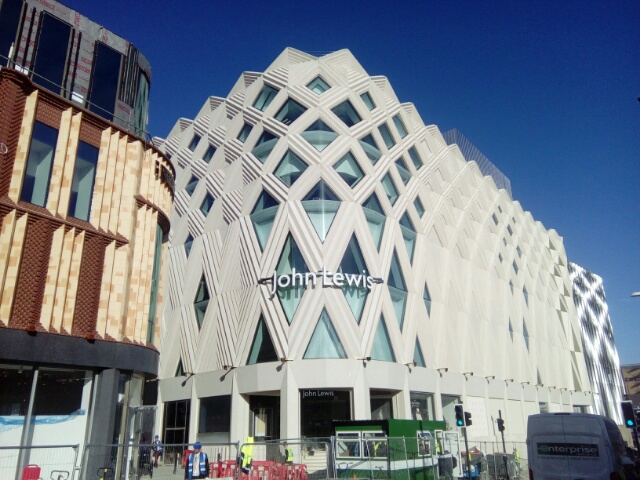
Take a walk down George Street and listen to people talking, watch them pointing, hear them gasping, chuckling and generally appreciating the transformation of a desperately grim part of town into something that’s worth lingering along and looking at.
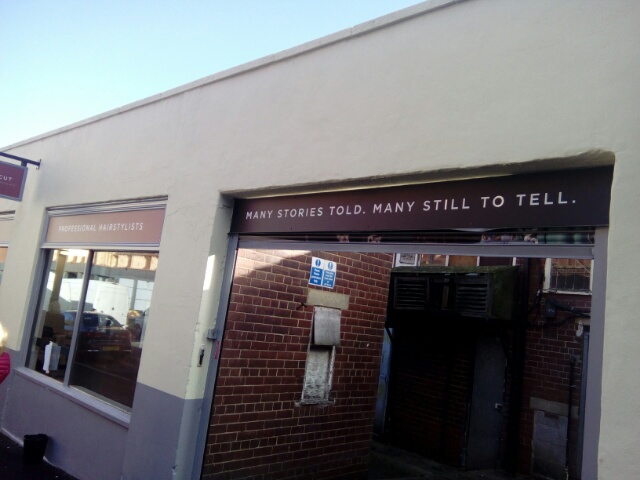
I’ve walked down here dozens of times in the past few months and for every negative, mean, critical comment that’s been expressed I’ve heard at least ten indicating delight and approval and pride.
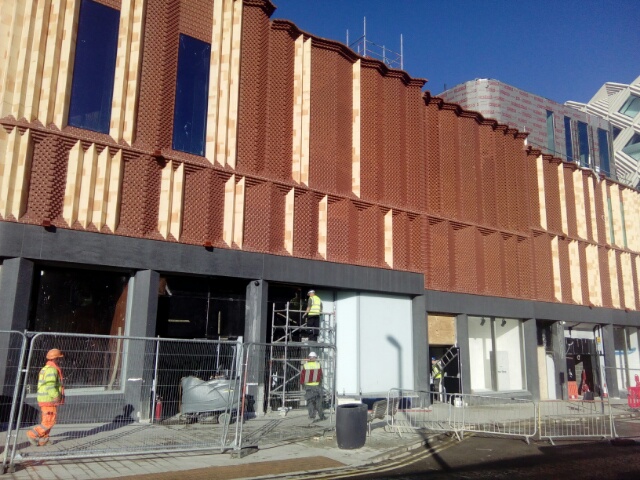
Got to say this cheers me up too.
While I don’t fall into raptures like the architectural critic of the Guardian, and I take much of the self-promoting narrative of the architects and developers with a pinch of salt on my tongue in my cheek (“retail is secondary” my arse; this is not “civic space”; and that isn’t Schoenbergian brickwork, it’s just panels of identical, precast and pretty monotonous material strung together nicely) I’d still agree that this place works on the whole.
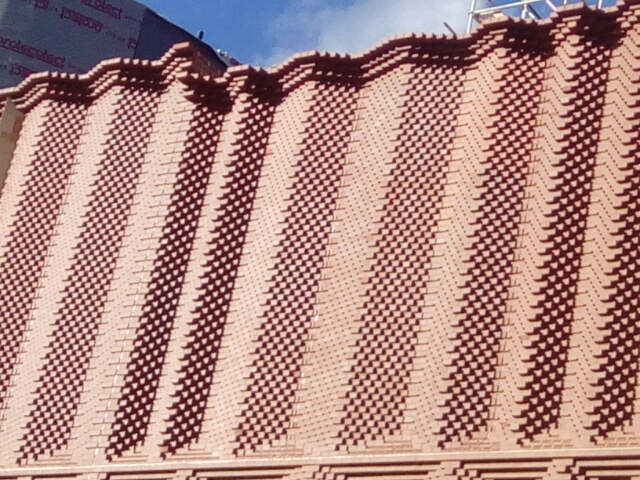
True, the diamond windows are disorientating (the outside of the building doesn’t tally with the inside, look!)
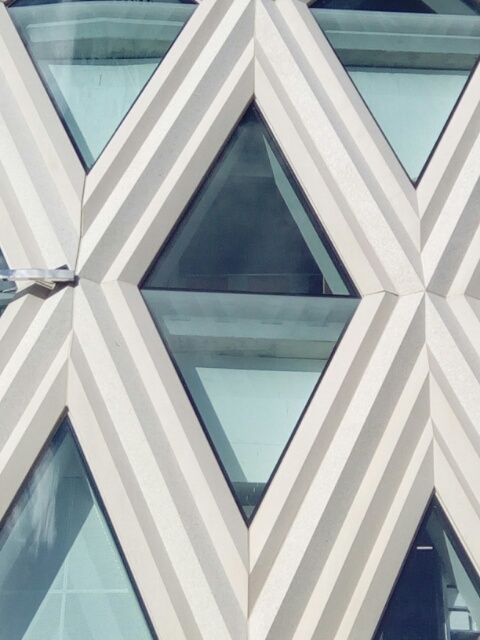
those bloody blanks in the wall make me want to slap the architect (has he never walked past a wall like this and groaned?)
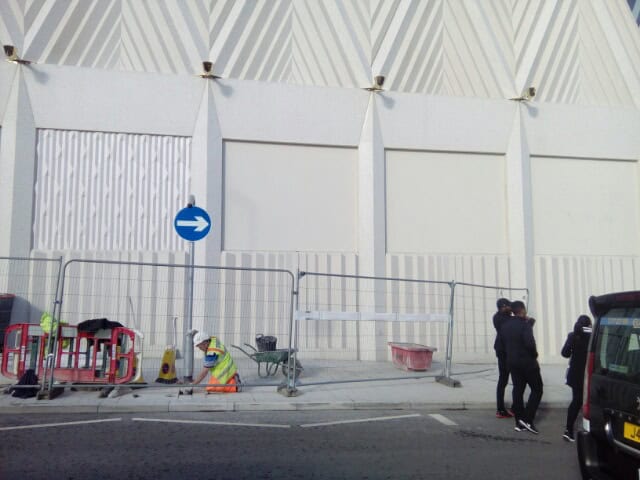
And, let’s face it, the John Lewis shop looks less like a cool, calculated geodisic dome and more like a giant cartoon jewellery box than anything else (which is why I’d like to state now that if Hammersons ever want to commission some public art to adorn and glorify the space inside, it should be in the form of a life-sized ballerina, twirling to a jingly tune on a raised platform of red velvet. Come on Leeds, if we got to have kitsch let’s show them how kitsch should be done!)
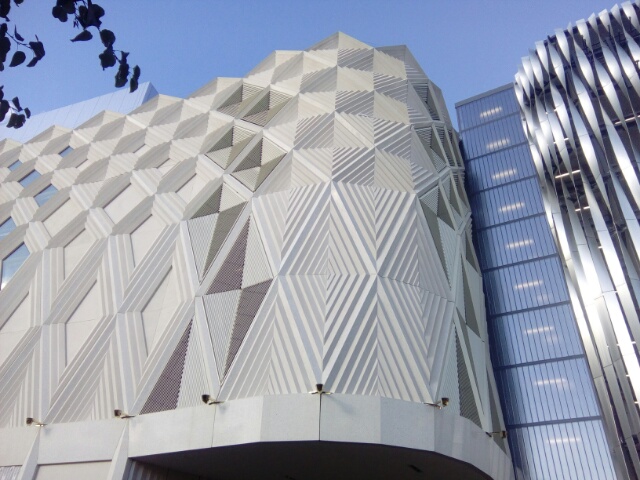
Most of us will never buy anything here. Many of us will never step a foot inside. But that doesn’t mean we can’t enjoy the spectacle. Even if that’s just passing by on the 48 bus.
Great article and I totally agree on many levels. But we can get conned very easily. Only this week I have been in London and seen the identical car park facade near a John Lewis. I think there is the corporate style and we have got it. Similar to the Leeds Met rusty sinking ship at the top of town, there’s an almost identical one at Manchester Met. Just don’t get me started on the concept work of Urban Splash! Some architects have one idea and they stick to it. That’s quite sad really, never mind unimaginative
I don’t take any notice of what architects and developers tell us about how vibrant, iconic, original etc. their buildings are. And I agree that a lot of it is a con – off the shelf design… I still like the car park, even though I know it’s probably been done before.
There are some valid comments on the architecture, although I know JL is waiting for gold panels to arrive to improve some of the facades with Eastgate. On the whole, I think this is a huge uplift for this part of town though and works well with Leeds architecture.
I would take issue with the first part of your article though. John Lewis is one of the best examples of ethical practice in our country. Sports Direct may be cheap, but they’re screwing over our working class every day. John Lewis promises to be Never Knowingly Undersold; the oldest price match in our country, and is famously a partnership. If only all companies operated like this, giving profits to their partners.
John Lewis Leeds will also be unparalleled in stocking locally sourced items – the store is a massive showcase to Yorkshire produce from independents across our county that could never, on their own, afford retail space in Central Leeds.
Victoria Gate may be supported by smaller, expensive chain stores but we’ve got it the right way round here. The headliner is an ethical, responsible business supported by the chains – not the other way round, which is what we see far too often. Independents run down with greedy corporates ruling. Not here.
In addition to this, the thousands of jobs provided can only be a good thing, while we also need to remember to be proud of Leeds’ retail. Yes many cities now are dominated by shopping, but Leeds’ history is retail. Leeds was the epicentre of textile manufacturing and gave rise to brands like M&S and Burton. The arcades of Leeds are some of the oldest in the world and our market is nationally famous. Our retail assets are unrivalled in the UK, if not Europe. Shopping is in Leeds’ DNA and while its not the way forward for every town and city, for Leeds it’s its proudest asset.
But the first part of the piece was quoting directly from the Victoria Gate website… that’s precisely the demographic the shops are aiming for?
And I have nothing against John Lewis. I don’t know anything about them to be honest. But nothing I’ve seen going by the new building persuades me that they’ll have anything I want. But then I’ve never been in any of the shops in Victoria Quarter or Trinity either even though I walk through both regularly and enjoy the architecture.
Like I said, I like the building. It’s a massive improvement.
Ah yes, John Lewis, an employer who refuses to recognise the independent trade unions that their ‘partners’ belong to! They also outsourced their cleaners in the Oxford St shop, making sure that they were not partners, and then stood by while the outsourced company cut jobs and hours. After cleaners in an independent union there went on strike, they managed to stop compulsory redundancies and win a pay rise.
http://www.independent.co.uk/news/business/news/knowingly-underpaid-john-lewis-hit-by-cleaners-protest-7888976.html
I’m not saying they are as bad as Sports Direct but it’s utterly inaccurate to depict them as some kind of virtuous workers’ co-op either.
For me you never take the aesthetics of architecture too seriously since at the end of the day any building can be fairly easily removed from the urban fabric if it is no longer regarded as pleasing to the eye or more likely has outstayed its economic usefulness.
It is also important not to over emphasise the role of architects themselves in outcome of the appearance of the buildings they produce since it was only for a short period in the post war years that the design ideology of “progressive” architects coincided with the needs and wishes of their corporate clients in the public and private sectors. This, of course, was the period of heroic modernism of the stripped back international style and to your taste either re-imagined city centre development or destroyed the best of Victorian heritage.
For various reasons, for good or ill this era passed away together with any ideals which were arguably implicit in the modernist values this architecture represented. What followed was a period in which the architecture profession became increasingly marginalised in the processes and debates which surrounded the “regeneration” of cities and the role consumption in the economy. Increased commercial competition within the profession as architecture itself became internationalised meant that any notion of idealism went out of the window and in the end what mattered was only what was a client would buy. Architecture effectively became nothing more than the cladding to the interests which drove development. Buildings above all are expected to perform economically; any other features of attractiveness, sensitivity to context, adding something to “urbanity” are purely ancillary. This is form follows function but not in the way that was originally intended.
So in this instance we have to ask whose interests were driving the development of Victoria Gate how have these impacted on what we have now seen built and only then can we substantially critique what we see before us.
I would sum the issues that arise from this play of interests between John Lewis, the “anchor store” retailer, Leeds City Council, the planning authority and general city “booster” and Hammersons the developers quite simply as “you want the brand – you get the building”.
For John Lewis, that epitome of metropolitan hygge consumer culture avant le mot, the route to expanding profits has been a march to the north, opening new outlets and creating a new audience for its stores amongst the indignant aspirant middle class or amongst southern emigres nostalgic for a retail experience unavailable in the country’s wilder provinces. Striking north in the last decade or so John Lewis revamped an older store in Sheffield, opened in the Trafford Centre Manchester, Newcastle, Liverpool and York. Leeds was evidently not thought suitable to be offered a first tranche opening or the processes were not in place for the development of a site or building.
For the City Council the lack of this iconic brand was a major blow to their claim to be the premier retail destination in the north. So it became a political priority alongside the creation of an arena (again Leeds lagged behind other cities) to add John Lewis to the “offer”. Having more retail space would increase the take form the business rate which could be recycled into other “boosterist” projects such as sports and cultural events, following in the wake of Manchester albeit many years behind. The vague hope of which was to improve the image of the city to inward investors and the mobile middle class some of whose influence might remotely trickle down to the poor of the city.
For Hammerson’s the interest was to expand their commercial property portfolio beyond their existing Victoria Quarter into new adjacent spaces: their particular market pitch being to the income consumer and the prestige brand. So we are talking an integrated new Victoria Quarter Quarter.
Linking all this to the building itself you would begin by examining its general orientation and the location of its major elements. Firstly, I would argue that this is not about Eastgate. This is about a face towards Vicar Lane and the market creating an ensemble for the shopper linking through to Briggate, the Corn Exchange and the ultimately to the Civic trust’s dream of an independent retail offer around Kirkgate.
Of course a car park is essential as no one shopping here is expected to arrive by bus but instead of concealment maybe underground or underneath the shops it is made a feature symbolising that this is a regional resource.
Beyond these elements we reach John Lewis’s requirements for building which represents “the values of their brand”. So we have something which is easily identifiable within the urban fabric as a John Lewis store which is “on trend” with striking decoration, classically white (at the moment) representing their commitment to ethical retailing but also with heritage references which are supposed to represent a respect and embeddedness in “place”. Obviously it will need the corporate signage to identify the building and to further brand it up.
After this it is up to the architects to develop some story around their design (because there is no longer a dominant architectural narrative which to relate) and to come up with something literally concrete.
At this stage the city planners, the councillors on the City Plans Panel get involved and other worthies such as the Civic Trust get involved but really to very limited effect. So we get what we are going to get from the combined interests of John Lewis, Hammersons’s and our Civic Boosters.
For me personally the development is a complete mess visually with far too many materials being used in a relatively small area, stylistically the building has very little resonance with anything going on around it and is completely over decorated. Obviously it completely invalidates the symmetry of Eastgate which was there before.
If it is an overall visual improvement depends on your point of view and the version of “vibrant urban environment” you prefer. Personally for various reasons I quite like what was there – an untidy row of shops behind, a popular bar and a police fortress which told its own story of oppression. I don’t like but completely get the need for sterilised urban retail spaces which are behaviour-managed to destroy the very vibrancy and inclusion they profess to need. In the setting of this part of town it will now be the people who shop in the market regularly who will provide the “exotica” the up-market consumer demands.
Thinking about the future of Victoria Gate I reflect on the history of another of Leeds’s retail innovations what is now The Core and which began life correct me if I am wrong as the Scofield centre way back years ago. At the time it too reflected the best of Thatcher’s retail architecture with loads of brass, a lift exterior to the various balconies, a food court etc etc. No doubt at the time it was argued to express visually the heritage of Leeds’s retail. Shortly after it was named as “carbuncle of the year” or some such in a national newspaper and generally went into economic decline.
Perhaps in twenty years’ time we will see a similar deterioration in Victoria Gate which will house the 2030’s equivalent of JD Sports and the sparkling decoration degraded to nice shade of grey-brown. Fortunately or not I shall not be around to see.
Look beyond firm to function. It’s a black hole sucking the life out of everything around it as it hoovers up wealth and returns it to investors…
It’s a city centre. And until and unless me and thee can afford to do something different it’s amusing to behold… and I was being facetious.
If I may I’ll have a second bite now
Maybe it’s worth reflecting on the “political architecture” surrounding Victoria gate in a bit more detail because tragically you could not make it up except perhaps here in Leeds.
First up the area around Eastgate and the Kirkgate market could not be a better symbol for what was once known as the “two speed city” – only this is two speed shopping. I have to ask myself is there really going to be any “synergy” between the visitors to the open air market and Victoria Gate as one of the market stall holder said on Calendar – “if you are going to spend £300 on a jumper you are not going to come here and spend £3 on one. It would only make you feel foolish”.
Of course the idea of the “two-speed city” was promoted by a former Labour Administration who had ambitious plans to “narrow the gap”. Fortunately, this was quickly “mainstreamed” before it became an electoral liability to be replaced by strap line “the competitive and compassionate city”.
The idea of “compassion” seems to chime quite well with what Victoria Gate represents at its most acute – the rich going about their business in fancy surroundings whilst at the same time perhaps conscience ridden they offer something in the way of philanthropy to the poor at a time when our publicly funded health and social care services are fading away. Perhaps the Leeds Community Foundation should open an office there to encourage giving.
I’m beginning to see now why the term Victoria was chosen. Leeds after all loves to celebrate its Victorian heritage, arcades, Town hall etc but possibly not in terms of the social conditions, its slums, cholera outbreaks at the time and its lack of any decent public provision.
Of course the biggest irony is that Victoria Gate opens in the face of what is quite likely to be a period of rising inflation, a weakening pound and a retrenchment in consumer spending – although how much this will actually impact Hammerson’s elite customer base is hard to say.
This is also possibly a time when the seduction of neo-liberal economics and hyper-consumption which have dominated the last 40 years is on the wane. So here it is just as the wave is breaking Leeds invests for the future.
As I say you couldn’t make it up.
Reminds me of the old slogan for Holbeck Urban Village: “Relive the Revolution”… cos the first time was so bleedin’ great!
I’d say Victoria Gate was chosen to imply an extension of the Victorian Quarter, which is actually Edwardian, other than Country Arcade and Cross Arcade. At that title implies a certain gentility.
People have said in this thread that Leeds has always been about retail. Really? Apart from textiles the city was the world’s biggest manufacturer of boots, with tanners and dyers all along Meanwood Road for decades. There were chemicals, soap. We were major manufacturers of well over 100 different things until the bottom dropped out after WW1.
Yes, there was retail, and we did have the massive Co-op on Albion St. and The Grand Pygmalion (which ended up as C&A) where Trinity is now. But go back 100 years and the city centre was filled with small businesses, at least the parts that weren’t inhabited by the poor in all the yards. As the population becomes more suburban, however, it’s inevitable a city centre will become more and more retail. For decades, though, the market was a major part of that. For most families, except the rich, shopping there was part of coming into Leeds.
Even the areas we now consider rich, like that Victoria Quarter, had small, independent business – the Doll’s Hospital toy shop, and opposite it a place that sold all manner of odd electrical items. A musical instrument shop, etc.
They all supported their owners and the city. They could afford the rent in those locations. We’ve gentrified the city centre beyond compare, so that it’s largely identikit brands now. Leeds has vanished up its own aspirational shopping arse.
Also the world’s biggest flax manufacturer for a long time.
It’s some years since I left Leeds – and it’s changed immensely in that intervening time. However, looking at the newest architectural concoction, Victoria Gate, it seems to me like someone had plans to do a mini-Gherkin in homage to that phallus-extraordinaire down here in the South, more commonly known as 30 St Mary Axe – but sadly the budget for Leeds could only run to a few floors instead of many more…
An old mate who has lived in London for the last 20 years came up to visit yesterday. We went to Bradford for an old times sake drink. Any criticism of Leeds should be seen in the totally depressing context of what could have happened in Leeds too. Surely we need highest common denominator not lowest common denominator?
Absolutely. But that doesn’t mean we have to take our eyes off what’s happening here?